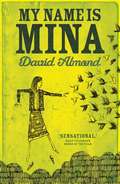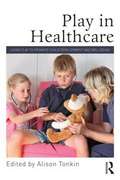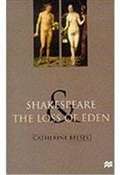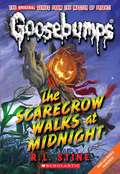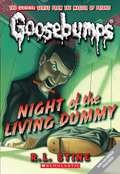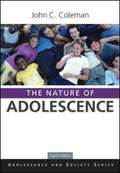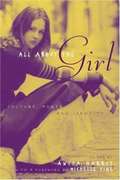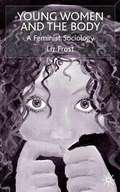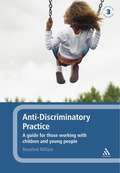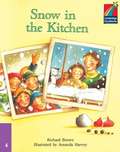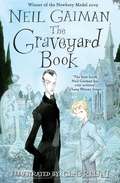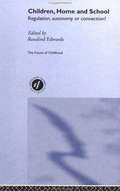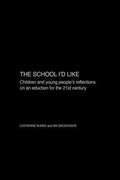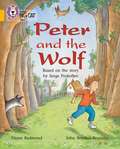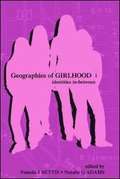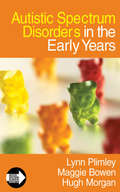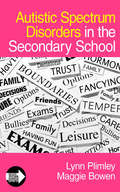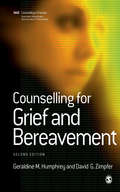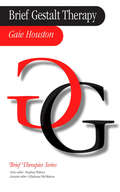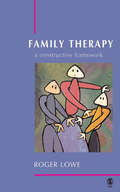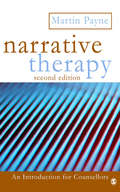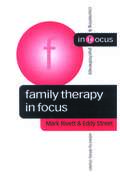- Table View
- List View
My Name is Mina (PDF)
by David Almond'There's an empty notebook lying on the table in the moonlight. It's been there for an age. I keep on saying that I'll write a journal. So I'll start right here, right now. ' This is the prequel to David Almond's debut novel 'Skellig' which was winner of the Carnegie Medal and the Whitbread Children's Book Award.
Play In Healthcare: Using Play To Promote Child Development And Wellbeing
by Alison TonkinThe importance of play in children's health and care services, both as a form of therapy and as a distraction, is often overlooked. This unique text promotes developmentally appropriate provision within healthcare settings for children and young people and provides an introduction to the underpinning knowledge and skills. Covering core content - such as the role of play in child development, relevant anatomy and physiology, the concept of resilience, health promotion, developing appropriate provision and working in diverse healthcare settings - each chapter: makes links with the NHS Knowledge and Skills Framework and the Children's Workforce's Common Core of Skills and Knowledge begins with an overview of the chapter objectives contains a variety of activities such as reflective exercises, case studies and practical tasks that will promote both skills and knowledge needed in the workplace. concludes with a selection of additional useful resources and further reading suggestions. Designed for all healthcare professionals who work with children and young people, including those studying to become health play specialists and children's nurses, this text provides practical examples of how all members of the multidisciplinary team can help to support children's play.
Shakespeare And The Loss Of Eden: The Construction Of Family Values In Early Modern Culture (PDF)
by Catherine BelseyThis account of Shakespeare's plays, in conjunction with early modern images of Adam and Eve, locates the construction of family values in cultural history and politics. The author seeks to show the pleasures and anxieties generated in the period by the domestication of desire, parental love and cruelty and the relations between siblings and discusses how Shakespeare's plays explore these themes. 0-333-77084-6 Hardcover
Goosebumps: The Scarecrow Walks at Midnight (PDF)
by R. L. StineThe best-selling scare series of all time brings you a thrilling repackage of the field of screams! Jodie loves visiting her grandparents' farm. Okay, so it's not the most exciting place in the world. Still, Grandpa tells great scary stories. And Grandma's chocolate chip cookies are the best. But this summer the farm has really changed. The cornfields are sparse. Grandma and Grandpa seem worn out. And the single scarecrow has been replaced by twelve evil-looking ones. Then one night Jodie sees something really odd. The scarecrows seem to be moving. Twitching on their stakes. Coming alive . . . 9781407157511
Goosebumps: Night of the Living Dummy (PDF)
by R. L. StineDiscover the fan-favorite thriller and chiller that first introduced the world to the wooden face of fear. The puppet who pulls all the strings. None other than Slappy the Dummy!
The Nature of Adolescence, 4th Edition
by John C. ColemanThe fourth edition of this successful textbook provides an up-to-date introduction to all of the key features of adolescent development. While drawing on the North American literature on adolescence, it highlights European perspectives and also provides unique coverage of the topic by summarising and reviewing what is known about adolescence from a British viewpoint. Comprehensively updated and rewritten, this edition includes material on new topics such as: The development of the adolescent brain Sleep patterns in adolescence Parenting programmes for parents of teenagers Health, including sport and exercise, nutrition and obesity, and mental health Education and schooling Young people's use of digital technologies New approaches to resilience and coping. The book places a particular emphasis on a positive view of adolescence, and the author develops a new theoretical perspective which looks at how young people themselves construct and shape their own developmental pathways. Interview material taken from discussions with adolescents is included throughout the book, and there are sample essay questions and PowerPoint lecture slides available online. This is an essential text for anyone studying human development at undergraduate and postgraduate level, as well as on postgraduate courses for professionals including teachers, social workers, health workers, counsellors, and youth workers. 9780415564199
The Nature of Adolescence, 4th Edition (PDF)
by John C. ColemanThe fourth edition of this successful textbook provides an up-to-date introduction to all of the key features of adolescent development. While drawing on the North American literature on adolescence, it highlights European perspectives and also provides unique coverage of the topic by summarising and reviewing what is known about adolescence from a British viewpoint. Comprehensively updated and rewritten, this edition includes material on new topics such as: The development of the adolescent brain Sleep patterns in adolescence Parenting programmes for parents of teenagers Health, including sport and exercise, nutrition and obesity, and mental health Education and schooling Young people's use of digital technologies New approaches to resilience and coping. The book places a particular emphasis on a positive view of adolescence, and the author develops a new theoretical perspective which looks at how young people themselves construct and shape their own developmental pathways. Interview material taken from discussions with adolescents is included throughout the book, and there are sample essay questions and PowerPoint lecture slides available online. This is an essential text for anyone studying human development at undergraduate and postgraduate level, as well as on postgraduate courses for professionals including teachers, social workers, health workers, counsellors, and youth workers. 9780415564199
All About the Girl: Culture, Power, and Identity
by Anita Harris Michelle FineThis groundbreaking collection offers a complicated portrait of girls in the 21st Century. These are the riot grrls and the Spice Girls, the good girls and the bad girls who are creating their own "girl" culture and giving a whole new meaning to "grrl" power. Featuring provocative essays from leaders in the field like Michelle Fine, Angela McRobbie, Valerie Walkerdine, Nancy Lesko, Niobe Way and Deborah Tolman, this work brings to life the ever-changing identities of today's young women. The contributors cover all aspects of girlhood from around the world and strike upon such key areas as schooling, sexuality, popular culture and identity. This is new scholarship at its best.
Young Women and the Body: A Feminist Sociology (PDF)
by Liz FrostYoung Women and the Body sets out to examine why the current generation of young women seem to be deeply unhappy with their own bodies. Dieting and disguising are commonplace, and inflicting serious harm by no means rare in fourteen to eighteen year olds. Despite prophesies to the contrary boys and adults are suffering far less. Drawing on feminist social constructionist perspectives the book seeks to examine this epidemic of body-hatred.
Anti-Discriminatory Practice: A Guide for Those Working with Children and Young People (PDF)
by Rosalind MillamFor those who work in childcare and educational settings, there is an ethical and legal responsibility to promote inclusive practice and to take into account children's cultural, ethnic, religious and linguistic backgrounds. Now in its third edition, Anti-Discriminatory Practice has been restructured to ensure that the information is as accessible as possible for those training and working in childcare and education. As well as including recent research and current best practice, Rosalind Millam has fully updated the content to take account of the impact of recent legislation and resulting legal requirements. Practical suggestions on how to achieve and develop inclusive practice are provided, along with activities to encourage practitioners to examine and reflect upon their own attitudes towards anti-discriminatory practice. Topics covered include: race, religion and culture; major religions beliefs; the role of play and development; identity and self-esteem.
Snow In The Kitchen (PDF)
by Richard BrownA series of ELT readers for young learners of English. I was ill and I couldn't go out in the snow, but Mum had a wonderful idea.
The Graveyard Book (PDF)
by Neil Gaiman Chris RiddellAn original adventure story about a boy raised by the resident ghosts, ghouls and spectres of a local graveyard. From the inimitable, bestselling author Neil Gaiman.
Children, Home and School: Regulation, Autonomy or Connection? (PDF)
by Rosalind EdwardsIn contemporary western societies, there are increasing emphases on children being the responsibility of their parents, contained within the home, and on their compartmentalisation into separate and protected organised educational settings. Thus 'home' and 'school' form a crucial part of children's lives and experiences. This book explores the key institutional settings of home and school, and other educationally linked organised spaces, in children's lives, and the relationships between these. It presents in-depth discussions concerning new research findings from a range of national contexts and focuses on various aspects of children's, and sometimes adult's, own understandings and activities in home and school, and after school settings, and the relationship between these. The contributors assess children from a variety of backgrounds and circumstances and consider how these children see and position themselves as autonomous within, connected to or regulated by home and school. Discussion of the impact of policy and practice developments on the everyday lives of these children is also included.
Children, Home and School: Regulation, Autonomy or Connection?
by Rosalind EdwardsIn contemporary western societies, there are increasing emphases on children being the responsibility of their parents, contained within the home, and on their compartmentalisation into separate and protected organised educational settings. Thus 'home' and 'school' form a crucial part of children's lives and experiences. This book explores the key institutional settings of home and school, and other educationally linked organised spaces, in children's lives, and the relationships between these. It presents in-depth discussions concerning new research findings from a range of national contexts and focuses on various aspects of children's, and sometimes adult's, own understandings and activities in home and school, and after school settings, and the relationship between these. The contributors assess children from a variety of backgrounds and circumstances and consider how these children see and position themselves as autonomous within, connected to or regulated by home and school. Discussion of the impact of policy and practice developments on the everyday lives of these children is also included.
The School I'd Like: Children And Young People's Reflections On An Education For The 21st Century
by Catherine Burke Ian Grosvenor Dea BirkettIn 2001, The Guardian launched a competition called The School I'd Like, in which young people were asked to imagine their ideal school. This vibrant, groundbreaking book presents material drawn from that competition, offering a unique snapshot of perceptions of today's schools by those who matter most - the pupils. The book is wonderfully illuminated by children's essays, stories, poems, pictures and plans. Placing their views in the centre of the debate, it provides an evaluation of the democratic processes involved in teaching and learning by: identifying consistencies in children's expressions of how they wish to learn highlighting particular sites of 'disease' in the education system today illustrating how the built environment is experienced by today's children posing questions about the reconstruction of teaching and learning for the twenty-first century. This book offers a powerful new perspective on school reform and is essential reading for all those involved in education and childhood studies, including teachers, advisors, policy-makers, academics, and anyone who believes that children's voices should not be ignored. 9780415301152 9786610073207 9780203439074
Collins Big Cat, Band 09, Gold: Peter and the Wolf
by Diane Redmond John Bendall-Brunello Cliff Moon Collins Big Cat StaffThis book presents Serge Prokofieff's famous musical story about young Peter and the Wolf in the style of a play with four scenes. The cast of characters on page 2 shows how Prokofieff used a different musical instrument to represent each character. With the help of a narrator, the story reveals, how Peter outwits the big bad wolf. *Gold/Band 9 fiction books offer developing readers literary language and stories with distinctive characters. * Text type - A playscript of a traditional tale. *A poster on pages 22 and 23 recaps on elements of Peter's character, around which children can discuss the story. * Curriculum links - Music: Exploring sounds. * This book has been levelled for Reading Recovery.
Geographies of Girlhood: Identities In-Between
by Pamela J. Bettis Natalie G. AdamsGeographies of Girlhood: Identities In-Between explores how adolescent girls come to understand themselves as female in this culture, particularly during a time when they are learning what it means to be a woman and their identities are in-between that of child and adult, girl and woman. It illuminates the everyday realities of adolescent girls and the real issues that concern them, rather than what adult researchers think is important to adolescent girls. The contributing authors take seriously what girls have to say about themselves and the places and discursive spaces that they inhabit daily. Rather than focusing on girls in the classroom, the book explores adolescent female identity in a myriad of kid-defined spaces both in-between the formal design of schooling, as well as outside its purview--from bedrooms to school hallways to the Internet to discourses of cheerleading, race, sexuality, and ablebodiness. These are the geographies of girlhood, the important sites of identity construction for girls and young women. This book is situated within the fledgling field of Girls Studies. All chapters are based on field research with adolescent girls and young women; hence, the voices of girls themselves are primary in every chapter. All of the authors in the text use the notion of liminality to theorize the in-between spaces and places of schools that are central to how adolescent girls construct a sense of self. The focus of the book on the fluidity of femininity highlights the importance of race, class, sexual orientation, and other salient features of personal identity in discussions of how girls construct gendered identities in different ways. Geographies of Girlhood: Identities In-Between challenges scholars, professionals, and students concerned with gender issues to take seriously the everyday concerns of adolescent girls. It is recommended as a text for education, sociology, and women's studies courses that address these issues.
Geographies of Girlhood: Identities In-Between (PDF)
by Pamela J. Bettis Natalie G. AdamsGeographies of Girlhood: Identities In-Between explores how adolescent girls come to understand themselves as female in this culture, particularly during a time when they are learning what it means to be a woman and their identities are in-between that of child and adult, girl and woman. It illuminates the everyday realities of adolescent girls and the real issues that concern them, rather than what adult researchers think is important to adolescent girls. The contributing authors take seriously what girls have to say about themselves and the places and discursive spaces that they inhabit daily. Rather than focusing on girls in the classroom, the book explores adolescent female identity in a myriad of kid-defined spaces both in-between the formal design of schooling, as well as outside its purview--from bedrooms to school hallways to the Internet to discourses of cheerleading, race, sexuality, and ablebodiness. These are the geographies of girlhood, the important sites of identity construction for girls and young women. This book is situated within the fledgling field of Girls Studies. All chapters are based on field research with adolescent girls and young women; hence, the voices of girls themselves are primary in every chapter. All of the authors in the text use the notion of liminality to theorize the in-between spaces and places of schools that are central to how adolescent girls construct a sense of self. The focus of the book on the fluidity of femininity highlights the importance of race, class, sexual orientation, and other salient features of personal identity in discussions of how girls construct gendered identities in different ways. Geographies of Girlhood: Identities In-Between challenges scholars, professionals, and students concerned with gender issues to take seriously the everyday concerns of adolescent girls. It is recommended as a text for education, sociology, and women's studies courses that address these issues.
Autistic Spectrum Disorders in the Early Years
by Lynn Plimley Maggie Bowen Hugh Morgan'An extremely helpful, compact guide for anyone working in early years education. . . provides clear information for all professionals who work with children from birth to five with autistic spectrum disorders. . . A short, accessible and reader-friendly book that addresses the key issues' - "Nursery Education " Looking at the early years of a child's life, this book provides information on the services that are available for those from birth to five years, and addresses issues related to identification, assessment, teaching and learning and family support. It is illustrated with case studies provided by parents and practitioners. The following areas are discussed: o the Code of Practice for SEN & the SEN and Disability Discrimination Act o identification and assessment o good practice examples of multi-agency collaboration and provision o partnership with parents o social skills and behaviour o alternative intervention and home-based programmes o the transition from pre-school to school. Professionals in Health, Social Services and Education, pre-school playgroups, nursery staff, parents and carers will all find this book useful. Conference Information The Good Autism Practice (GAP) conference is based on the successful foundations of the Good Autism Practice (GAP) journal, which provides a platform for acknowledging and sharing good practice in autism.
Autistic Spectrum Disorders in the Secondary School
by Lynn Plimley Maggie Bowen'I liked the way it dealt with the difficult issues such as mental health, sexuality and future employment in a clear and direct way, providing well thought out, practical responses. ' 'Easy to read yet informative. ' 'Very accessible in an area of SEN that is now a key area of concern. ' ' Captivating, good presentation with the case studies, reflective oasis and points to remember. ' 'Very useful for Sencos and teachers. ' - "Judging Panel for NASEN/TES Book Award " 'There can be no doubt that the action suggested by the authors to improve outcomes for pupils with ASD, would benefit the inclusion of all pupils' - "Special Needs Information Press " 'The book gives a clear insight into some of the issues which are important from the perspective of the pupil, the challenges they face and the behaviours that can result. It openly addresses the impact of these behaviours on a school and offers clear guidance and strategies. The options given are realistic, practical and achievable and the Reflective Oasis sections offer an ideal starting point for self-evaluation and staff training' "- Mike Ridout, Head of Access and Inclusion Service, Bridgend LEA " 'All those involved in education at secondary level including senior managers and governors will find this concise book informative in helping them to understand the needs of their pupils with ASD' -" Ian Attfield, Advisory Teacher ASD, Birmingham Specialist Support Service " 'The book not only gives sound advice, it helps the reader to find a wider range of sources of support and information. . . a useful, practical guide that makes the organisation of inclusive education achievable' - "Special " 'The book does have a number of useful strategies and tips, but it provides more than just a list of practical points. Support staff are encouraged to reflect upon their own practice and that of their school. . . The book is well worth buying and should appeal both to support workers and their managers' - "Support For Learning "'The book fills a niche by distilling and providing information to busy teachers. . . an important little book that is quite readable and may be very useful to its intended audience' "- American Psychological Association " When a young person with autistic spectrum disorders enters secondary school, there are lots of new factors to consider. This books looks at: "making good transitions from primary school "how to provide helpful INSET for colleagues (including teachers, senior managers, support staff and lunchtime supervisers) "using a special interest as a tool for learning "record-keeping, IEPs and sharing information across the school "subject disapplication and formal examinations "social strategies to employ in a large high school "useful tips for staff - what to do and what not to do "work experience, careers and self-advocacy The importance of working closely with parents is also covered, as is dealing with challenging behaviour. '. . . the book not only gives sound advice, it helps the reader to find a wider range of sources of support and information. . . The authors have not sought to minimise the difficulties or to pretend that schools and individuals will not have to change or adapt, nor have they avoided difficult questions. What they have one is to write a useful, practical guide that makes the organisation of inclusive education achievable' - "Resource File "
Counselling for Grief and Bereavement
by David Zimpfer Geraldine M Humphrey`The authors have done their homework in reading and consulting with the prominent literature, especially regarding children. All this effort gives the book a solid background foundation and makes it readable, and well-usable, for both lay counsellors and professional providers, and for all of us who are engaged in the delicate and rewarding endeavor of Grief Therapy' - Naji Abi-Hashem, Clinical & Cultural Psychologist, Berkeley, California Praise for the First Edition: `The book provides an absorbing and challenging journey through the possible process involved in bereavement work, and encourages one to think broadly about how one can approach a bereaved person... this was a book I enjoyed reading very much, and which I found both theoretically sound and practically helpful' - Bereavement Care (Cruse) Counselling for Grief and Bereavement, Second Edition is a bestselling, introductory guide for professionals who work with people experiencing bereavement through death and other forms of loss. Focusing on practical assessment and intervention strategies, Geraldine Humphrey and David Zimpfer guide readers through the essential theory and skills needed to work with clients in a way which sensitively facilitates the process of grief, initiates healing and promotes a sense of growth. Setting out the broad principles for practice, the authors go on to show how these can be applied in working with individuals, families and groups and in relation to specific issues including chronic and life-threatening illnesses, palliative care and complicated grief. Carefully chosen case examples illustrate the counselling process, while specific attention is paid throughout to ethical considerations and the possible need for referral. This fully revised and updated Second Edition features a new chapter on working with children and adolescents: both from the perspective of young people who are grieving losses and those who are receiving palliative care as patients. While focusing on the practical, the book provides a firm theoretical base by explaining key concepts such as attachment, grief and resilience. Geraldine M. Humphrey is Counsellor in the Department of Psychology at the North Canton Medical Foundation, specializing in death, illnesses, and non-death and grief. David G. Zimpfer is former Director of the Cancer Center of Ohio.
Brief Gestalt Therapy
by Ms Gaie Houston`Anybody with the slightest interest in brief therapy should read this book. Now that the initial controversy over brief therapy has begun to subside it is great to see how brief therapy works in practice. Gaie Houston's book is part of a series published by SAGE which sets out to do this - and hers is particularly illuminating and accessible. As she points out Gestalt is better equipped than many mainstream therapies to be applied to situations with extreme time constraints because it is both flexible and it acknowledges the part that can be played by other therapies. But what propels Houston's book out of the hum drum - or indeed the defensive (or offensive) diatribes about short therapy which have appeared over the past few years - is her vivid accounts of real-life sessions, both one to one and group, which punctuate the text' - Amazon Review Brief Gestalt Therapy demonstrates how the Gestalt approach can be used effectively in brief interventions with clients. Gestalt's distinctively integrative nature and emphasis on a highly co-operative working alliance, make it particularly suited to brief work. The book sets out the basic theory and principles of Gestalt and looks at each phase of the therapeutic process from initial assessment through the beginning and middle stages to the ending of the work. It presents clear, practical strategies for therapists to follow and in particular examines: } aspects of Gestalt which are especially relevant to brief work -} the elements of successful therapy -} ways of improving skills. Brief Gestalt Therapy includes vignettes and detailed case studies which bring the theory alive. It will contribute much to both existing literature on Gestalt therapy and also brief therapy, and will be invaluable to trainee and practising Gestalt therapists.
Family Therapy: A Constructive Framework
by Dr Roger Lowe`I liked this book. Though I am not a family therapist, like most mental health nurses I try to bear in mind the family relationships of individuals I am working with. This is an enlightening text which not only offer a framework with which we can better understand the severe psychopathologies seen in forensic work, but also gives examples of how it may be used therapeutically' - Mental Health Practice `I think this is an important book that crystallises complex theory into a user-friendly model, using case material and discussions from the therapeutic community. A must have for counsellors working with families, this will form part of the recommended reading on the Family Counselling course' - Barbara McKay, Relate Head of Training, Relate News `The book provides a good overview of a number of recent approaches to working with families as well as how the author thinks about them' - Stephen Bray, Nurturing Potential `Roger Lowe achieves the almost impossible task of bringing together various theories, techniques and case examples in clear and accessible ways. Readers of all disciplines, from front-line hard-pressed practitioners to students on therapy and social work courses, will be grateful for the simple and, above all, useful way he tackles the burning questions that arise in working with the family group. Highly recommended!' - Harvey Ratner, Brief Therapy Practice, London Family Therapy introduces practitioners to the principles of using a constructive and collaborative approach with families. The approach builds on a strengths-based philosophy and focuses on enhancing family resilience and competence in a way that is both time-efficient and comprehensive. It brings together skills from contemporary models such as solution-focused, narrative and conversational therapies and adapts them to the specific challenges of working with family relationships. It is the first book to systematically integrate these influential approaches and apply them to family work. Setting out a clear framework for practice, Roger Lowe describes the key tasks for the therapist as: · hosting meetings · negotiating concerns, and · evoking family members' personal and relationship resources. The framework is designed to be clear but flexible, and to allow practitioners to adapt it to their own situational needs. For example, it suggests ways for practitioners to selectively 'borrow' from other therapeutic models while retaining a constructive orientation. It also explores ways in which therapists can use their 'inner' conversation during a session as a tool to overcome obstacles to the therapeutic process. Although there is a common belief that the approach is only suited to brief interventions, the author also describes ways of working constructively over a longer period of time. Throughout the book, case studies are included to show how the constructive framework is used in practice and to highlight a range of challenging situations that may be encountered during family therapy. Roger Lowe's book provides a refreshingly different approach to working with families, which chimes with the growing interest in constructive approaches. It is written for trainees and for practitioners who are interested in developing their skills in this collaborative and optimistic approach.
Narrative Therapy
by Martin Payne`A thought provoking and interesting book that will be of interest to nurses and others supporting patients' - Accident and Emergency Nursing `It is a relevant and timely book that will remind therapists of the importance of the telling of client's stories as an important component of the therapeutic process. Whatever approach we use, the client's story will be a part of what we work with, so a sophisticated questioning of what 'stories/narratives' are will benefit our work. This book is a good starting point for such an exploration. It's an interesting book that will appeal to counsellors ready to challenge or add to their existing approach' - Therapy Today Narrative Therapy: An Introduction for Counsellors, Second Edition, offers a clear and concise overview of this way of working without oversimplifying its theoretical underpinnings and practices. Narrative therapy places peoples' accounts of their lives and relationships at the heart of the therapeutic process. Its main premise is that the telling and re-telling of experience by means of guided questioning can facilitate changed, more realistic perspectives, and open up possibilities for the person seeking assistance to position him- or herself more helpfully in relation to the issues brought to therapy. Drawing on the ideas of Michael White and David Epston, this fully revised, extended and updated second edition incorporates recent developments in narrative theory and practice, and introduces developments initiated by other narrative therapists worldwide. New material has been added around counselling for post-traumatic reactions, couples conflict and a sense of personal failure. The book is illustrated with extensive examples of practice with individuals and couples. It is ideal for anyone on training courses in narrative therapy, and also for counsellors who wish to consider common ground between narrative ideas and their current approach. Martin Payne is an independent therapist and trainer in Norwich, UK.
Family Therapy in Focus
by Dr Eddy Street Mark RivettDrawing on many years' experience in practice, teaching and research, Mark Rivett and Eddy Street present philosophical, sociological and empirical views of family therapy. Balancing the perceived benefits against the potential limitations, they pose questions, which challenge those within the profession to think hard about their role. } does family therapy work? } can those most in need really be helped? } is family therapy a means of social control? } who does professionalization help? While most texts offer a straightforward and uncritical perspective, in contrast Family Therapy in Focus aims to stimulate debate among practitioners and to help trainees adopt a more reflective and critical attitude towards their own professional development and the development of their profession.
